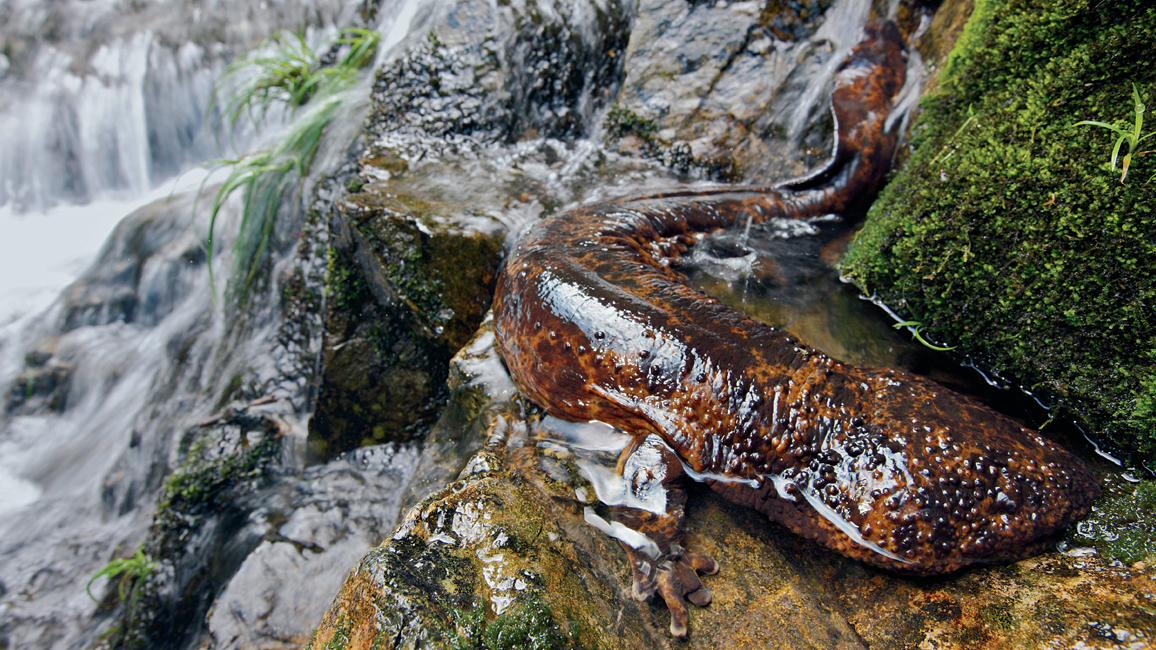
Japanese Giant Salamander
By Marty Crump; photos by Cyril RuosoThe wrinkly, slimy creature is covered with warts and folds of skin. Tiny eyes peer out from its wide, flat head. With massive mouth agape, it shows off small but sharp teeth, all the better to fight and bite!
The animal still looks like its ancestors that roamed Earth before the dinosaurs. But here it is, alive in the present. It’s a Japanese giant salamander–the world’s second-largest amphibian. (China’s giant salamander is slightly larger.)
This huge salamander lives in cold, fast-flowing mountain streams and rivers–but only on three islands of Japan (see map). It can grow to nearly five feet in length. That could be longer than you are tall!
WRINKLES AND SLIME
Adult Japanese giant salamanders breathe through their skin. This works well because the cold, rushing water of their homes holds a lot of dissolved oxygen. All those wrinkles and folds mean even more skin for breathing. The salamanders often rock back and forth, which keeps oxygen-rich water circulating around them.
Most nocturnal (active at night) animals have large eyes that take in as much dim light as possible. Giant salamanders are nocturnal, but their tiny eyes don’t see well. Instead, the salamanders use smell and touch to find food. They eat just about anything in the water that moves, from insects and worms to freshwater crabs, fish, and frogs. They even eat each other! These salamanders often wait in ambush, facing downstream. When unsuspecting fish swim by, the salamanders lunge and slurp them up.
When something disturbs a Japanese giant salamander, it oozes a milky, sticky mucus. Yuck! This mucus smells like sansho, the Japanese pepper plant. For this reason, the Japanese people call their salamander sansho-uo (“pepper fish,” even though it isn’t a fish, of course).
THE NEXT GENERATION
In late August and September, male giant salamanders move to nesting sites. These are usually long burrows in riverbanks, hollowed-out areas on stream bottoms, or spaces under rocks. A large male, called a den master, claims his nest site by plopping down at the entrancenoct. He fights other males that try to steal his site. Some of these fights end with serious injuries or even death.
Several females may enter the nest site. Each one lays 400-500 yellowish eggs in two strings, like beads on a necklace. The den master quickly fertilizes the eggs. He must watch out for other males that try to sneak in and fertilize the eggs themselves.
The females leave after laying their eggs, and the den master is left to care for all the eggs. While the eggs develop, the male guards them against fish and other male giant salamanders that try to eat them. He rocks back and forth to stir up the eggs, providing them with a steady flow of oxygen-rich water. The eggs finally hatch in about three months, and Dad’s job is done.
THE FUTURE?
There are a lot fewer Japanese giant salamanders now than there used to be. Some people still catch and eat them, even though that’s against the law. When people cut down trees near rivers, dirt slides into the water. That can destroy salamander hiding and nesting spots. It can also harm smaller animals that the salamanders depend on for food. And dams keep salamanders from getting to where they want to go.
Another threat is the Chinese giant salamander, which was brought into Japan as a source of food for people. But some Chinese salamanders escaped into the wild, where they compete with the Japanese salamanders for food and space. They also breed with their Japanese cousins, but the mixed-species offspring can’t have babies. The more that happens, the sooner the species might disappear.
The good news is, scientists are learning all they can about how Japanese giant salamanders live in the wild. And others are teaching people how to better share the environment with the salamanders. With luck, efforts such as these will help the salamanders survive.
CELEBRATE!
Some Japanese people call their giant salamander hanzaki, which means “cut in half.” (This name refers to the mistaken belief that the salamander can grow new body parts when it is cut in two.)
There’s an old Japanese legend about a huge salamander that terrorized the countryside. A warrior allowed himself to be swallowed by this “monster.” He then killed it with his sword and crawled back out. But the salamander’s spirit caused crops to fail and people to die. To make peace with the spirit, people built a shrine to honor the hanzaki. And now, every year in this part of Japan, local people hold a Hanzaki Festival to celebrate their giant salamander.
BORN IN THE USA
A third species of giant salamander lives in the eastern United States. Like its Asian cousins, the hellbender (above) lives in fast-flowing streams and rivers–and is also declining in number. But unlike its Asian cousins, a hellbender grows to be only about two feet in length. Some people call hellbenders “snot otters” because of their slimy skin.
“GIANT!” originally appeared in the March 2015 issue of Ranger Rick magazine.
(Click on each image above for a closer view of the story.)



















